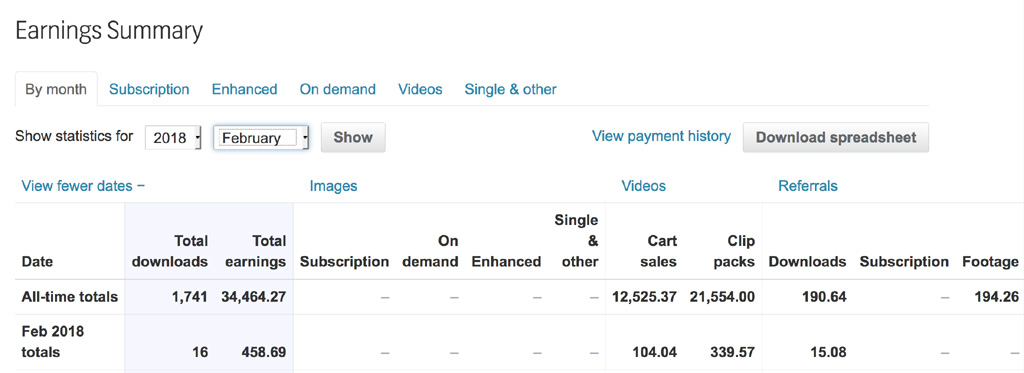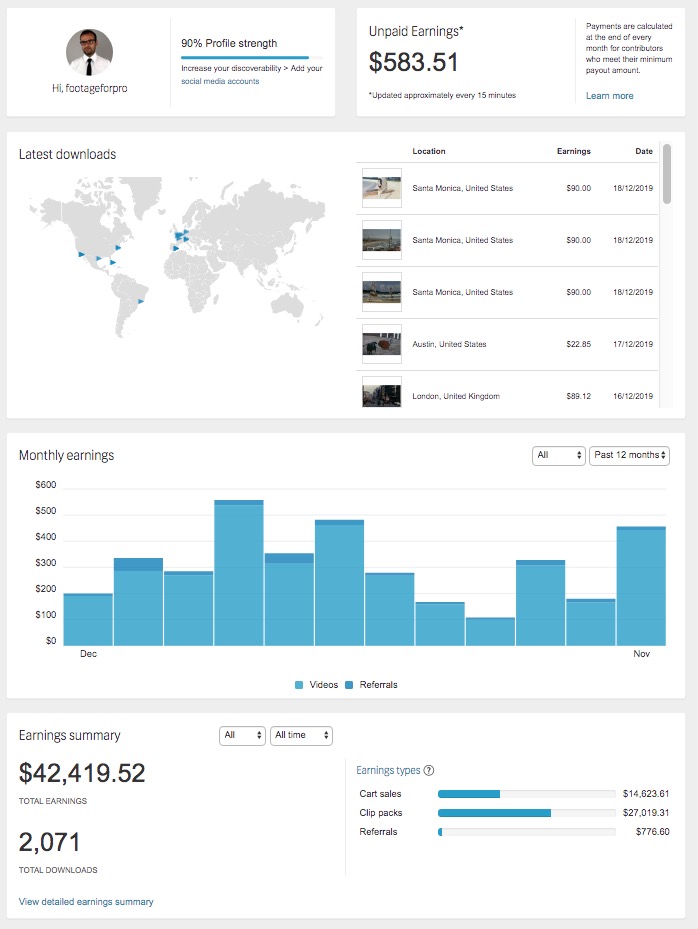Thinking about turning your photography into a steady income stream? Shutterstock is one of the biggest platforms out there for photographers and videographers to sell their work. It’s like a giant digital marketplace where businesses, designers, and creators find images, videos, and music for their projects. But how does it actually work when it comes to earning money? Well, Shutterstock operates on a royalty-based model, meaning you get paid a certain amount each time someone downloads your photo. The amount you earn depends on various factors, including your contributor level and the type of license purchased. It’s a pretty straightforward setup, but there’s more beneath the surface that can influence your income.
Factors That Influence Your Earnings on Shutterstock

Your earnings on Shutterstock aren’t set in stone—they can vary quite a bit depending on several key factors. Let’s break down the most important ones:
- Contributor Level: Shutterstock rewards active contributors. When you first start, you’re a Standard contributor, earning a certain royalty rate. As you upload more approved images and meet specific milestones, you can advance to higher levels like Enhanced or Exclusive contributor. Higher levels mean higher royalty percentages, so staying active and consistent really pays off.
- Type of License Purchased: Shutterstock offers Standard and Extended licenses. Standard licenses are the most common and cheaper, while Extended licenses are more expensive and grant broader usage rights. The license type directly affects your payout—the more comprehensive the license, the higher your earnings per download.
- Download Volume: Naturally, the more your photos are downloaded, the more you earn. Building a diverse and high-quality portfolio helps attract more buyers, increasing your download count over time.
- Image Quality and Relevance: High-resolution, well-composed, and relevant images tend to perform better. Keywords also matter—accurate and detailed tags help your images show up in searches, boosting download potential.
- Exclusive vs. Non-Exclusive Content: If you choose to upload your photos exclusively to Shutterstock, you might earn higher royalty rates. Non-exclusive photos can be sold elsewhere too, but usually at lower rates, so weigh the benefits based on your goals.
- Contributor Tier and Promotions: Occasionally, Shutterstock runs promotions or special programs that can temporarily boost your earnings or provide bonuses. Keeping an eye on these opportunities can give your income a nice bump.
In short, your earnings are influenced by a mix of your activity level, the quality and relevance of your images, licensing choices, and strategic decisions about exclusivity. The key is to stay consistent, keep improving your portfolio, and understand how each factor plays into your overall revenue. With patience and effort, Shutterstock can become a reliable source of income for your photography passion.
How Shutterstock Pays Photographers and Contributors

So, you’re curious about how the whole payment process works on Shutterstock? Well, let me break it down for you. When you upload your photos, you become a contributor, and Shutterstock offers a pretty straightforward way to earn money from your images. The payment system is designed to be transparent, but there’s a bit of a learning curve if you’re new to stock photography.
First off, Shutterstock operates on a royalty-based model. This means that every time someone downloads one of your photos, you earn a royalty fee. The amount you make depends on several factors, including your contributor level, the type of license purchased (standard or enhanced), and the number of downloads you’ve accumulated over time.
Here’s how the process works in simple terms:
- Upload Photos: You submit your high-quality images to Shutterstock.
- Approval Process: Shutterstock reviews your photos to ensure they meet quality standards. Once approved, your images go live.
- Sales and Downloads: Customers find and purchase your photos through Shutterstock’s marketplace.
- Royalty Payouts: Shutterstock calculates your earnings based on the number of downloads and your contributor level.
Shutterstock offers different payout tiers, which are based on your lifetime earnings. As you earn more, your payout percentage increases, rewarding your continued contribution. The payout thresholds vary, but generally, once you’ve accumulated a minimum amount (often around $35), you can request a payout through PayPal, Payoneer, or Skrill.
Another interesting aspect is the tier system, which encourages contributors to upload quality images consistently. Higher tiers get access to better royalty rates. So, the more quality images you upload and the more they sell, the more you stand to earn per download.
In summary, Shutterstock pays contributors through a commission model that rewards both the number and quality of your photos, with payments processed regularly once you hit the minimum payout threshold. It’s a fair system that’s built to motivate photographers to keep uploading and improving their portfolios.
Average Earnings Per Photo on Shutterstock
Now, let’s get to the fun part—how much can you actually expect to earn per photo on Shutterstock? The truth is, it varies a lot depending on several factors, but we can look at some averages to give you a ballpark idea.
On average, Shutterstock contributors earn between $0.25 to $2.50 per download for standard licenses. For enhanced licenses, the earnings are higher, often ranging from $10 to $50 or more, because these licenses are purchased for larger projects or commercial use.
Here’s a quick breakdown:
License Type Average Earnings Per Download Standard License $0.25 – $2.50 Enhanced License $10 – $50+ Keep in mind, your actual earnings per photo depend heavily on your contributor level. For example:
- Contributor Level 1: Lower royalties, fewer benefits.
- Contributor Level 4 or 5: Higher royalty rates and more exposure.
Additionally, your earnings also depend on the popularity of your photos. High-quality, in-demand images tend to sell more often and for higher prices. If you’re just starting out, don’t expect to make a fortune overnight. Many contributors see modest earnings initially, but as they build a robust portfolio and improve their photography skills, their income per photo can increase significantly.
To maximize your earnings, it’s a good idea to focus on niches with high demand, such as business, health, technology, or lifestyle images. Also, optimizing your keywords and descriptions can help your photos get discovered more easily.
In summary, while the average earning per photo on Shutterstock might seem modest at first, consistent uploads of high-quality images can lead to a steady income stream. Over time, especially as you climb the contributor levels, your earnings per photo can increase quite a bit, turning your hobby into a lucrative side hustle or even a full-time gig.
Tips to Maximize Your Income from Shutterstock Photos
So, you’ve started uploading your photos to Shutterstock and are eager to boost your earnings. Great! Earning more isn’t just about uploading lots of images; it’s about being strategic. Here are some handy tips to help you get the most out of your Shutterstock portfolio.
1. Focus on Popular and Trending Topics
Keep an eye on current trends, seasonal events, and popular themes. Images related to holidays, new technologies, health, and lifestyle tend to perform well. Use tools like Google Trends or Shutterstock’s own trending sections to see what buyers are searching for right now.
2. Upload High-Quality, Unique Photos
Quality is king. Make sure your images are sharp, well-lit, and properly composed. Unique perspectives or niche subjects can also set your portfolio apart, attracting more buyers and increasing your chances of sales.
3. Use Effective Keywords and Descriptions
Keywords help buyers find your images. Be descriptive and specific, using relevant words without overstuffing. Think about what someone would type in when searching for a photo like yours. Well-optimized metadata can significantly increase your visibility.
4. Diversify Your Portfolio
Don’t just stick to one type of image. Upload a variety—people, objects, landscapes, concepts—to appeal to different buyers. The broader your portfolio, the higher your chances of making sales.
5. Take Advantage of Shutterstock’s Contributor Tools
- Use the Submit Multiple Images feature to upload efficiently.
- Participate in Special Calls for Submissions or themed assignments.
- Monitor your sales data to understand what works best for your audience.
6. Stay Consistent and Keep Uploading
Regular uploads keep your portfolio active and enhance your chances of being featured or recommended. Set a schedule that works for you, whether that’s weekly or bi-weekly, and stick to it.
7. Engage with the Community
Join Shutterstock contributor forums or social media groups. Sharing tips, asking for feedback, and learning from others can open up new ideas and strategies to increase your income.
Conclusion and Final Thoughts on Earning Money on Shutterstock
Getting paid for your photos on Shutterstock can be a rewarding experience, especially if you understand how the system works and apply smart strategies. Remember, your earnings per photo can vary widely based on factors like image quality, licensing type, and how many times your images are downloaded.
While the potential for income is there, it often takes time, consistency, and a bit of marketing savvy to truly maximize your earnings. Focus on creating high-quality, relevant images, optimize your metadata, and stay active in uploading new content. Over time, you’ll build a diverse portfolio that attracts more buyers and boosts your revenue.
Most importantly, enjoy the process! Photography is a creative pursuit, and earning money from it should feel rewarding, not stressful. With patience and persistence, you can turn your passion into a steady income stream on Shutterstock. Happy uploading!


